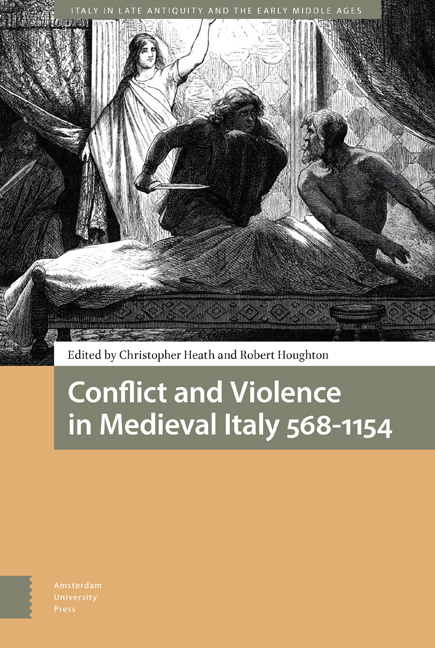Book contents
- Frontmatter
- Table of Contents
- Abbreviations
- Preface
- 1 Introduction: Discordant Minds and Hostile Nations
- 2 Morbidity and Murder: Lombard Kingship’s Violent Uncertainties 568-774
- 3 Insurgency and Counterinsurgency in Lombard Italy (c600-700)
- 4 Troubled Times: Narrating Conquest and Defiance between Charlemagne and Bernard (774-818)
- 5 ‘Nec patiaris populum Domini ab illis divinitus fulminandis Agarenis discerpi’: Handling ‘Saracen’ Violence in Ninth-Century Southern Italy
- 6 Formosus and the ‘Synod of the Corpse’: Tenth Century Rome in History and Memory
- 7 Sex, Denigration and Violence: A Representation of Political Competition between Two Aristocratic Families in Ninth Century Italy
- 8 ‘Italy and her [German] Invaders’: Otto III’s and Frederick Barbarossa’s Early Tours of Italy – Pomp, Generosity and Ferocity
- 9 ‘I Predict a Riot’: What Were the Parmense Rebelling Against in 1037?
- 10 The Strange Case of Deusdedit and Pandulf: Two Accounts of Honorius II’s Election
- Afterword
- Index
8 - ‘Italy and her [German] Invaders’: Otto III’s and Frederick Barbarossa’s Early Tours of Italy – Pomp, Generosity and Ferocity
Published online by Cambridge University Press: 07 September 2022
- Frontmatter
- Table of Contents
- Abbreviations
- Preface
- 1 Introduction: Discordant Minds and Hostile Nations
- 2 Morbidity and Murder: Lombard Kingship’s Violent Uncertainties 568-774
- 3 Insurgency and Counterinsurgency in Lombard Italy (c600-700)
- 4 Troubled Times: Narrating Conquest and Defiance between Charlemagne and Bernard (774-818)
- 5 ‘Nec patiaris populum Domini ab illis divinitus fulminandis Agarenis discerpi’: Handling ‘Saracen’ Violence in Ninth-Century Southern Italy
- 6 Formosus and the ‘Synod of the Corpse’: Tenth Century Rome in History and Memory
- 7 Sex, Denigration and Violence: A Representation of Political Competition between Two Aristocratic Families in Ninth Century Italy
- 8 ‘Italy and her [German] Invaders’: Otto III’s and Frederick Barbarossa’s Early Tours of Italy – Pomp, Generosity and Ferocity
- 9 ‘I Predict a Riot’: What Were the Parmense Rebelling Against in 1037?
- 10 The Strange Case of Deusdedit and Pandulf: Two Accounts of Honorius II’s Election
- Afterword
- Index
Summary
Abstract
Otto III (r. 995-1002) and Frederick I (Barbarossa, r. 1152-1190) made several visits to Italy. Each came as king on the first visit and emperor on the second. The two rulers enacted and endorsed what we would consider today to be abhorrent acts of violence, during their second tours especially. This chapter examines the legitimacy of those acts in the context of the times, especially focusing on how the two rulers chose to present themselves – in action, in appearance and in written works. How their contemporary biographers portrayed them forms an important part of the narrative.
Keywords: Otto III, Frederick I, political violence, papacy, medieval Italy, Rome
Introduction
Milan, having tyrannised over the neighbouring town of Lodi, came in for a terrible siege from the Emperor Frederic Barbarossa, and having been forced by famine to capitulate […] [in] 1162, was destroyed by the imperialists; but the town was soon rebuilt by the famous Lombard League, and the Milanese avenged their losses by the victory of Legnano.
For many centuries, and even nowadays, the sun, the wine and general lure of Italy have proven distracting, and at times fatal, to a succession of travellers and invading armies, particularly from the north. When I say ‘from the north’, I mean movement from the Germanic lands south across the Alps. For centuries kings and emperors crossed the Alps, descending south to the kingdom of Italy to parade, cajole and conquer with a display of pomp, generosity and cruelty. Their subjects in turn responded with subservience, cunning and revolt. The activities and the self-representation of two rulers, crowned at Aachen 170 years apart, serve as case studies. The first is Otto III, crowned King in 983. The second is Frederick I (also known as Frederick Barbarossa), crowned and anointed King in 1152. At that time to rule meant to travel. The reigns of Otto III and of Frederick Barbarossa were one long royal progress for both of them. When they did travel south of the Alps, was this different?
In this chapter I present and contrast two expeditions by Otto III to Italy, the first in 996 and the second in 997/998, with the first and second tours to Italy by Frederick in 1154/55 and 1158/1162.
- Type
- Chapter
- Information
- Conflict and Violence in Medieval Italy 568-1154 , pp. 243 - 264Publisher: Amsterdam University PressPrint publication year: 2021



